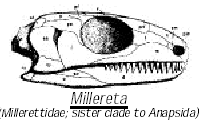 Millerettidae Romer, 1956 : Most primitive anapsid group? (Broomia, Heleophilus, Milleretoides, Milleretta, Millerettops, Milleropsis, Millerosaurus, Nanomilleretta (clearly oversplit and in need of revision!))
Millerettidae Romer, 1956 : Most primitive anapsid group? (Broomia, Heleophilus, Milleretoides, Milleretta, Millerettops, Milleropsis, Millerosaurus, Nanomilleretta (clearly oversplit and in need of revision!))| Anapsida | ||
| The Vertebrates | Millerettidae |
| Vertebrates Home | Vertebrate | Vertebrate |
|
Abreviated Dendrogram
Reptiliomorpha
├─Synapsida
└─┬─Eureptilia
│
└─Anapsida
├─┬─Millerettidae
│ └─Eunotosaurus
├─Mesosauridae
└─┬─Lanthanosuchoidea
└─┬─Bolosauridae
└─Procolophonia
├─┬─Nycteroleteridae
│ └─Pareiasauridae
└─Procolophonoidea
├─Owenettidae
├?─Testudines
└─Procolophonidae
|
Contents
Overview |
The Millerettids are one of several types of anapsid reptiles known from the Middle and Late Permian of Southern Africa. Like other early anapsids, they were superficially very similar to modern lizards in appearance, and probably lived a similar, insectivorous lifestyle. Yet they did have some intriguing adaptations. In contrast to the classic anapsidan model, in which the cheeks are solid, some millerettids have temporal openings (fenestra) of the synapsid sort behind the orbits (eye sockets), but these wese acquired independently.
The presence of a concave area at the back of the skull called a quadrate emargination implies that millerettids had an ear drum (tympanum) and could hear high-frequency airborne sounds. However, the stapes (the sound-conducting bone in the middle ear) are still more solid than those of later anapsids such as the procolophonoids, suggesting that their hearing was not as good (ref: UCMP).
Despite their primitive nature, Millerettids appear quite late in the fossil record, some 30 million or so years after the first appearance of the bolosaurids, who representa more specialised group. Many anapsids seem to have only appeared after a period of cryptic evolution, although whether this can account for their appearance so much later than the first and much more derived protorothyridids in the mid Carboniferous is another matter. As yet, no stratocladistic analyses have been performed to test against this, nor does there seme to be much or nay interest in such methodologies in the morphology-only dominated field of of early amniote evolution
Whenever they first evolved, Millerettids were common by the Capitanian age, and continued to flourish until the end of the Permian, co-existing alongside similar but more advanced anapsids such as nycteroleterids, owenettids, and procolophonids, as well as basal neodiapsids, captorhinids and younginiformes. What all this shows is that middle and late Permian terrestrial ecosystems were populated by a diverse range of generalised and basically lizard-like, anapsid and diapsid reptiles, constituting an ecosystem that may have been just as rich and diverse as today's environments. MAK120323
 Millerettidae Romer, 1956 : Most primitive anapsid group? (Broomia, Heleophilus, Milleretoides, Milleretta, Millerettops, Milleropsis, Millerosaurus, Nanomilleretta (clearly oversplit and in need of revision!))
Millerettidae Romer, 1956 : Most primitive anapsid group? (Broomia, Heleophilus, Milleretoides, Milleretta, Millerettops, Milleropsis, Millerosaurus, Nanomilleretta (clearly oversplit and in need of revision!))
Middle (Capitanian) to Late Permian of South Africa.
Phylogenetic definition: all taxa more related to Milleretta rubidgei Broom, 1938, than to Macroleter poezicus Tverdokhlebova & Ivakhnenko, 1984. (Cisneros et al 2008)
Anapsida : Mesosauridae + (Bolosauridae + Procolophonia) + *.
Length about 60 cm
Characters: Simple, conical teeth; retention of tabular, large supratemporal and postparietals; some forms with lateral temporal fenestra, but independently derived; lower temporal bar incomplete; stapes relatively small(?), light; impedance-matching ear likely; squamosal and quadratojugal embayed to support tympanum like diapsids (?) but unlike Testudines, which use quadrate; lizard-like?
Links: Introduction to Millerettidae; Nathis Fauna Reptilelen Dutch -- brief discussion); reptiles basic data); Kardong K summary of phylogenetic placement); PANGEA Italian -- quick summary and picture). ATW030304. Milleretta - All About Reptiles Paleofieldguide - Milleretta rubidgei, Millerosaurus - Wikipedia
checked ATW040118. This page MAK120323